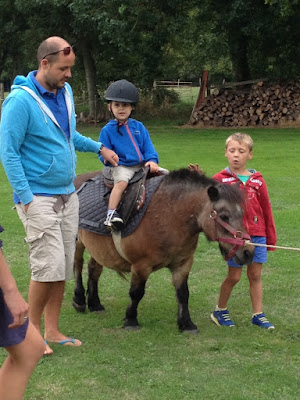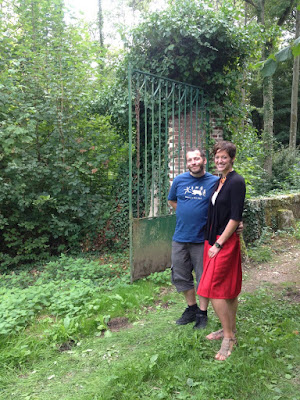I've been in France for a week and a half. This past weekend Pierre and I spent three of those days with his
family at the Moulin de Spoir, a farm and old mill on the river Eure outside
Chartres. The weekend was wonderful.
Pierre’s parents were very sweet to me, his sisters and their families
were great, and we threw a barbeque on Sunday for an assortment of friends,
neighbors, and family. Pierre and his mother are both accomplished cooks, so
there was no shortage of delicious food; the only challenge was saying no to a
cheese course before dessert. There was fly-fishing; there were walks in the
woods; there was excellent wine; there was a 10-km Sunday morning run through
the countryside with Pierre’s sisters, Mme Decker on a bike behind us.
 |
| Pierre's brother-in-law and nephews give Kinder, a tubby Shetland pony, his biannual exercise. |
After a drink, we left to see Chartres en Lumiere, the
city’s annual summer-long light display. Upon discussion, it was decided that
we would take the Dyane. This turned out to be a classic car I had heard
about—around Pierre one might call the car, one of Tof’s pet projects,
legendary—but not yet seen, the Citroen Dyane 6. A bright orange convertible
from the mid-seventies, the Dyane is somewhere between an antique and a jalopy—“A
great car,” Tof explained fondly, “although with this many people the ignition
might not start right away.”
This turned out to be something of an understatement. With
the Dyane geared in neutral and Tof at the helm, Pierre and I pushed the car the
length of Tof’s street, breaking into a jog as Tof yelled back at us through
the open driver’s side door, one flipflopped foot dangling. His scarf, an
orange that (intentionally or not) perfectly matched the Dyane, flapped out
along the side of the car as we painfully picked up speed. The engine finally sputtered
into life, and Pierre and I leapt in, panting.
“And here I was regretting not having worked out today,” I
gasped.
“You see? A multi-function vehicle,” Tof responded smugly.
“Just make sure you park on a hill,” Pierre muttered darkly
from the back seat.
We pulled the hood back, letting in a rush of autumn air,
and made our way towards the cathedral. Tof and Pierre pointed out monuments
and the apartments of people I had met along the way.
Once we found a declining slope to nestle the Dyane’s nose
down, we set out on a tour by foot. Our meanderings led us past bridges,
monuments, and historic buildings that served as backdrops for light
projections. I imagine it could only be maddening for those whose windows face
a projector—and as Pierre remarked, the energy use must be staggering—but the
result was lovely. The cathedral,
already a breathtaking structure, was the most stunning stop. Using traces of
pigment that have been found on interior stonework during restoration efforts
as a guide, the light designers had created a speculative suggestion of what
the cathedral could have looked like when first built and painted; the paint is
thought to have flaked off after a few generations, so no one really knows, but
the result was magnificent.
The rest of the weekend went on rollers, as the French would
have it, which is to say: went smoothly. Sunday afternoon Pierre hosted a cookout
and petanque at the Moulin de Vilaine, a 14th century stone water mill, which
was dismantled in large part by the French during the Second World War to keep
the invading Germans from occupying it.
The millstones are no longer in place, but some of the structure still
stands, and it is a perfect place to build a fire, throw a lawn party, or go
fishing, all of which happened Sunday.
 |
| The Moulin de Vilaine |
The afternoon wound down with a closely battled game of
petanque. Mme Decker proved to be a formidable opponent. She studied the
terrain, moved with decision, and unerringly nestled her metal boule gently against the cochonnet, or piglet, the small wooden
ball that serves as a goal. Roger, a master gardener and retiree with a set of
personally engraved boules, held the
score steady for my team; his signature move was a sort of cannon blast that
rarely failed to clear the earth around the cochonnet
of enemy boules. Brute force won out
over delicate sportsmanship, and our team took the win.
We left Monday after lunch, the necessities of the working world luring us back to Bordeaux. Up next: I will maybe get the inspiration to write something about Bordeaux! In the meantime, I'm pretty sure a cafe in a afternoon-lit square in front of some kind of stone monument is calling me. My life is full of hard decisions.
 |
| Roger, me, Pascal, and Laure: clearly look like winners to me. |



No comments:
Post a Comment